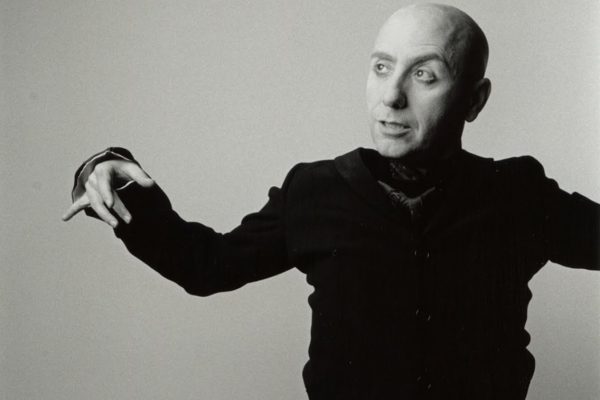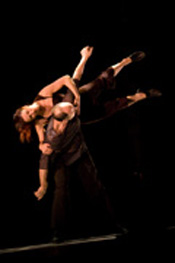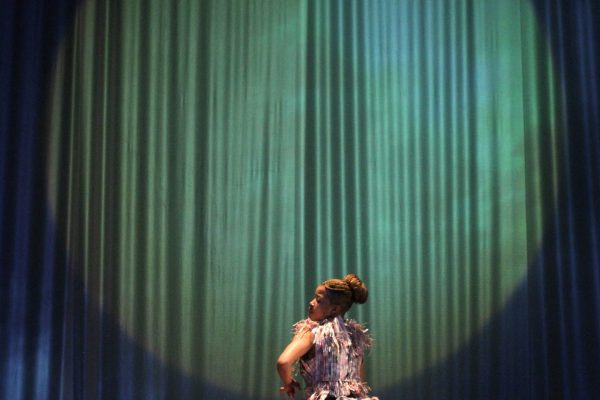Ballet BC’s Program 2, the second show of the company’s thirtieth season, presented two world premieres by choreographer Medhi Walerski. Each of the works, titled Prelude and Natus, filled the stage with the company’s seventeen dancers and apprentices and up to nine pre-professional dancers from Arts Umbrella’s Graduate Dance Program. In both, Walerski shows us the poetic beauty of life in progress.
This production of Prelude by Walerski was reworked from an earlier version that premiered for Ballet BC in 2014. Through a series of tableaux, each set to preludes from 24 Preludes for Violin and Piano and Preludes and Dreams composed by Lera Auerbach, dancers in solos, duets and ensembles brought to life intimate moments that came and went like breaths, as if each dance gave life to the next.
Andrew Bartee’s brief solo shot limbs in all directions before being intercepted by the ensemble. From there, Gilbert Small, whose sinuous upper body challenged perceptions of skeletal structure, emerged in a solo before being joined in a duet by Christoph von Riedemann, whose careful placement accented the shapes of the choreography.
There was a precision to the dancers’ wild limbs and twisting bodies. In past performances, I have noted the company’s physical prowess and stamina. Walerski’s choreography brings out a quieter, more harmonious side of their artistry that is equally powerful, speaking in thoughtful prose rather than aggravated shouts.
The central duet was danced by Rachel Meyer and Scott Fowler who, even when apart, were always reaching toward one another, expressing an immediacy that brought their performance to life. As though in dialogue with the dancers, the music shifted from soft piano to shrill notes of string instruments of different tempo and textures.
Even in silence, the dancers’ expressiveness was certain and clear. Fowler cast a striking image standing solo, breathing heavily under a spotlight that illuminated the shape of his expanding and contracting stomach. As the curtain descended on him, writhing and twisting alone on the floor, it seemed another moment was just beginning.
Natus was more theatrical and explored the themes of celebration and its rituals. It’s Walerski’s first work to incorporate text, and dancer Peter Smida, in the role of The Man, undertakes his spoken monologue with astute dramatic timing and exuberant vocal expression.
Natus begins while the audience is settling into their seats after intermission. Smida walked down an aisle calling “Tickets?” before launching excitedly into a list of items needed for some party to come. Meanwhile, a dancer in a nude leotard hangs in a fetal position halfway above the stage. It can be difficult to maintain continuity in a piece that teeters between the normal and the surreal, but Walerski’s articulate dance vocabulary and attention to dramatic pacing mastered the delicate balance.
Arousing re-enactments of a wedding, a funeral, a birthday, a coronation and the ubiquitous presence of applause throughout these moments are paired with a soundtrack that included snare drums, The Queen’s Funeral March by Henry Purcell and traditional Japanese drumming. For these scenes, costume designer Nancy Bryant dressed the ensemble in all-black pants and tops; gold detailing in the shoulders evoked ceremonial significance. Lighting design by James Proudfoot set apart each scene with dramatic shadows and spotlights, while a row of light bulbs downstage lent greater theatricality. A warped mirror placed upstage gave crumpled reflections of the onstage scenes while its scattered metallic glare visually accented the sharp pangs of the percussion.
Although complex, Walerski’s choreography is unhurried. In one extended scene, rows of dancers continuously sweep across the stage in opposing directions, creating a sense of unity. This relatively simple scene allowed for a moment of reflection.
Duets were like conversations — Kirsten Wicklund’s reckless fluidity succumbed to Christoph von Riedemann’s delicate touch, as his hands weightlessly lifted her limbs. Following, Tara Williamson and Gilbert Small moved as if one in their duet of intricate twists and lifts, and Racheal Prince and Brandon Alley twirled nimbly through tension in an effort to overcome the momentum of their movement.
For the last scene, the dancers, in nude leotards, were stripped of characterization and evoked something more primitive. Moving to rhythmic drumbeats, they danced in close unison through repeated phrases of low lunges and twists of the torso. The repetitive motions, performed seemingly to the point of exhaustion, expressed a conviction that lifted the piece to its climax.
In an interview the day following the premiere, Walerski shared his thoughts on Natus: “It’s more like a work-in-progress … I cannot say the piece is finished yet.” How true that is of life — ever a work-in-progress — and beautifully captured in these two works.
Tagged: Ballet, Choreography, Contemporary, Performance, BC , Vancouver




